


The Catskill Aqueduct, part of the New York City water supply system, brings water from the Catskill Mountains to Yonkers where it connects to other parts of the system.



The Catskill Aqueduct, part of the New York City water supply system, brings water from the Catskill Mountains to Yonkers where it connects to other parts of the system.
Construction commenced in 1907. The aqueduct proper was completed in 1916 and the entire Catskill Aqueduct system including three dams and 67 shafts was completed in 1924. [1] The total cost of the aqueduct system was $177 million (equivalent to $5,787,900,000in 2023). [2]
The 92-mile (148 km) aqueduct consists of 55 miles (89 km) of cut and cover aqueduct, over 14 miles (23 km) of grade tunnel, 17 miles (27 km) of pressure tunnel, and nine miles (10 km) of steel siphon. [3] The 67 shafts sunk for various purposes on the aqueduct and City Tunnel vary in depth from 174 to 1,187 feet (362 m). [4] Water flows by gravity through the aqueduct at a rate of about 4 feet per second (1.2 m/s). [5]
The Catskill Aqueduct has an operational capacity of about 550 million US gallons (2,100,000 m3) per day north of the Kensico Reservoir in Valhalla, New York. Capacity in the section of the aqueduct south of Kensico Reservoir to the Hillview Reservoir in Yonkers, New York is 880 million US gallons (3,300,000 m3) per day. [6] The aqueduct normally operates well below capacity with daily averages around 350–400 million US gallons (1,500,000 m3) of water per day. About 40% of New York City's water supply flows through the Catskill Aqueduct.
The Catskill Aqueduct begins at the Ashokan Reservoir in Olivebridge, New York, located in Ulster County. From the Ashokan Reservoir, the aqueduct traverses in a southeasterly direction through Ulster, Orange, and Putnam counties. It tunnels first beneath the Rondout Valley and Rondout Creek in the town of Marbletown, then beneath the Wallkill River in the town of Gardiner in Ulster County before flowing toward Orange County, New York. It crosses 1,100 feet (340 m) below the Hudson River bed at Storm King Mountain in Orange County before reaching Putnam County on the east side of the river at Breakneck Mountain. The aqueduct transports water from Ashokan as well as the Schoharie Reservoir, which feeds into Ashokan. [7]
The aqueduct then enters Westchester County, New York, and flows to the Kensico Reservoir, which also receives water from the city's Delaware Aqueduct. It continues from the Kensico reservoir and terminates at the Hillview Reservoir in Yonkers. The Hillview Reservoir then feeds City Tunnels 1 and 2, which bring water to New York City. If necessary, water can be made to bypass both reservoirs.

The Delaware Aqueduct is an aqueduct in the New York City water supply system. It takes water from the Rondout, Cannonsville, Neversink, and Pepacton reservoirs on the west bank of the Hudson River through the Chelsea Pump Station, then into the West Branch, Kensico, and Hillview reservoirs on the east bank, ending at Hillview in Yonkers, New York.
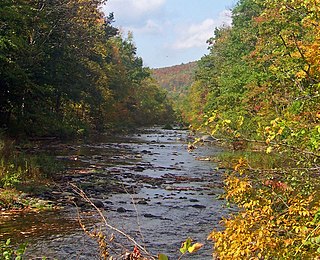
Rondout Creek is a 63.3-mile-long (101.9 km) tributary of the Hudson River in Ulster and Sullivan counties, New York, United States. It rises on Rocky Mountain in the eastern Catskills, flows south into Rondout Reservoir, part of New York City's water supply network, then into the valley between the Catskills and the Shawangunk Ridge, where it goes over High Falls and finally out to the Hudson at Kingston, receiving along the way the Wallkill River.
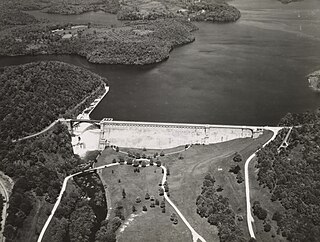
The New Croton Dam is a dam forming the New Croton Reservoir, both parts of the New York City water supply system. It stretches across the Croton River near Croton-on-Hudson, New York, about 22 miles (35 km) north of New York City.
New York City Water Tunnel No. 3 is a water-supply tunnel forming part of the New York City water supply system. It is being built by the New York City Department of Environmental Protection (NYCDEP) to provide New York City with a third connection to its upstate water supply. The tunnel will serve as a backup to Water Tunnel No. 1, completed in 1917, and Water Tunnel No. 2, completed in 1936.

Rondout Reservoir is part of New York City's water supply network. It is located 75 miles (121 km) northwest of the city in the Catskill Mountains, near the southern end of Catskill Park, split between the towns of Wawarsing in Ulster County and Neversink in Sullivan County. It is the central collection point for the city's Delaware System, which provides half its daily consumption.

A combination of aqueducts, reservoirs, and tunnels supplies fresh water to New York City. With three major water systems stretching up to 125 miles (201 km) away from the city, its water supply system is one of the most extensive municipal water systems in the world.

The Ashokan Reservoir is a reservoir in Ulster County, New York. It is at the eastern end of the Catskill Park, and is one of several in the region created to provide the City of New York with water. It is the city's deepest reservoir at 190 feet (58 m) near the dam at the former site of Bishop Falls.
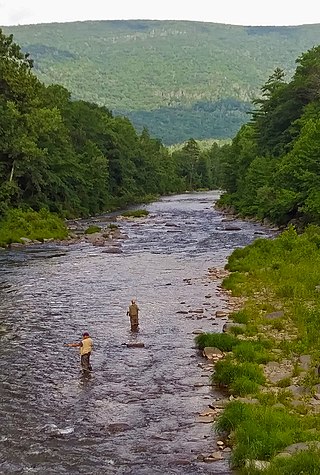
Esopus Creek is a 65.4-mile-long (105.3 km) tributary of the Hudson River that drains the east-central Catskill Mountains in the U.S. state of New York. From its source at Winnisook Lake on the slopes of Slide Mountain, the Catskills' highest peak, it flows across Ulster County to the Hudson at Saugerties. Many tributaries extend its watershed into neighboring Greene County and a small portion of Delaware County. Midway along its length, it is impounded at Olive Bridge to create Ashokan Reservoir, the first of several built in the Catskills as part of New York City's water supply system. Its own flow is supplemented 13 miles (21 km) above the reservoir by the Shandaken Tunnel, which carries water from the city's Schoharie Reservoir into the creek.

Neversink Reservoir is a reservoir in the New York City water supply system. It is located in the Catskill Mountain town of Neversink in Sullivan County, New York, 75 miles (121 km) northwest of the City.

The Schoharie Reservoir is a reservoir in the Catskill Mountains of New York State that was created to be one of 19 reservoirs that supplies New York City with water. It was created by impounding Schoharie Creek. Portions of it lie in the towns of Conesville and Gilboa in Schoharie County, Roxbury in Delaware County, and Prattsville in Greene County.
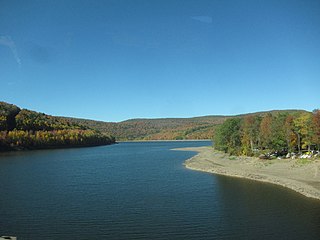
The Pepacton Reservoir, also known as the Downsville Reservoir, is a reservoir in Delaware County, New York on the East Branch of the Delaware River in the Catskill Mountains of New York. Part of the New York City water supply system, it was formed by the construction of Downsville Dam, and impounds over one-quarter of the East Branch's flow.

The Cannonsville Reservoir is a reservoir in the New York City water supply system in Delaware County, New York. It was formed by construction of the Cannonsville Dam on its west end, which impounded over half of the West Branch of the Delaware River. Lying on the western part of the Delaware Watershed, it is the westernmost of New York City's reservoirs. It was placed in service in 1964, and is the most recently constructed New York City-owned reservoir.

The Kensico Reservoir is a reservoir spanning the towns of Armonk and Valhalla, New York, located 3 miles (5 km) north of White Plains. It was formed by the original earth and gravel Kensico Dam constructed in 1885, which impounded waters from the Bronx and Byram rivers. In 1917, a new masonry dam was completed, replacing the old dam and expanding the water supply by bringing water from the Catskill Mountains over a distance of more than 100 miles.

The West Branch Reservoir is a reservoir in the New York City water supply system. Formed by impounding the upper reaches of the West Branch of the Croton River, it is located in the Putnam County, New York, towns of Kent, and Carmel, about 50 miles (80 km) north of New York City.
The Boyds Corner Reservoir is a small reservoir in Putnam County, New York. It is in the town of Kent, New York, and is about 50 miles north of New York City. It is the northernmost reservoir in the Croton River watershed, but is not part of the New York City water supply system's Croton Watershed. and was formed by impounding the middle of the West Branch of the Croton River, submerging the village of Boyds Corner.

The Bog Brook Reservoir is a 379-acre (153 ha) reservoir in the Croton Watershed in southern New York State, part of the New York City water supply system. It is located in the town of Southeast in Putnam County, approximately 38 miles (61 km) north of New York City. It was formed by the damming of Bog Brook, a small tributary of the East Branch of the Croton River. The reservoir was put into service in 1892, making it one of the older in the system.
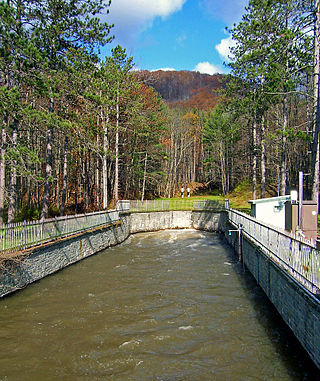
The Shandaken Tunnel is an aqueduct in Eastern New York State, part of the New York City water supply system. It was constructed between 1916 and 1924. The tunnel starts in Gilboa, New York at the Schoharie Reservoir, which is in the counties of Schoharie, Delaware, and Greene. The water flows south towards the Esopus Creek in Ulster County. It finally empties into a man-made pool in Allaben, New York, within the Town of Shandaken, and enters Esopus Creek there.

The Hillview Reservoir is a 90-acre (0.36 km2) storage reservoir in southeastern Yonkers, New York. It was built within a six-year period from 1909–1915 by the New York City Board of Water Supply to receive water from the newly constructed Catskill Aqueduct, which drained water from the Ashokan Reservoir and sent it down into the Kensico Reservoir, where it would, in turn, be drained back into a continuation of the Catskill Aqueduct, and sent into the Hillview Reservoir. Frank E. Winsor was the engineer in charge of construction of both Hillview and Kensico as well as 32 miles (51 km) of the Catskill Aqueduct.
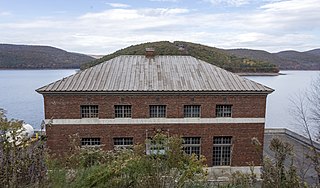
The East Delaware Tunnel is a 25-mile (40 km) aqueduct in the New York City water supply system. Located in the Catskill Mountains of New York State, it was constructed within a six-year period between 1949 and 1955 to transport drinking water from the Pepacton Reservoir to the Rondout Reservoir. The tunnel begins near the former site of Pepacton, New York, and ends near the former site of Eureka, New York, passing through Delaware County, Sullivan County and Ulster County. The tunnel has a maximum transmission capacity of 500 million US gallons (1,900,000 m3) per day and was constructed at a width of 11 feet (3.4 m).

[[File:Crotonrivermap.png|thumb|right|Map of the Croton River watershed. Note that this is not identical with the New York City water supply system's "Croton Watershed"{{efn|Numerous small natural lakes and ponds, as well as large Lake Mahopac, are part of the Croton River's watershed but not part of New York City’s supply system. A map of the actual Croton Watershed is found here. ]]